
Selly Oak is an industrial and residential area in south-west Birmingham, England. The area gives its name to Selly Oak ward and includes the neighbourhoods of: Bournbrook, Selly Park, and Ten Acres. The adjoining wards of Edgbaston and Harborne are to the north of the Bourn Brook, which was the former county boundary, and to the south are Weoley, and Bournville. A district committee serves the four wards of Selly Oak, Billesley, Bournville and Brandwood. The same wards form the Birmingham Selly Oak constituency, represented since 2010 by Steve McCabe (Labour). Selly Oak is connected to Birmingham by the Pershore Road (A441) and the Bristol Road (A38). The Worcester and Birmingham Canal and the Birmingham Cross-City Railway Line run across the Local District Centre.

Stirchley is a suburb in south-west Birmingham, England. The name likely refers to a pasture for cattle. The settlement dates back to at least 1658. Prehistoric evidence, Roman roads, and Anglo-Saxon charters contribute to its history. The Worcester and Birmingham Canal and the railways brought industry to the area. Stirchley's development is also linked to industries like screw-making and rubber manufacturing. Originally part of Worcestershire, Stirchley underwent administrative changes in 1911. Residential developments were established alongside the long-standing Victorian terracing which is associated with the suburb.
The city of Birmingham, in England, has a long military history and has been for several centuries a major manufacturer of weapons. It may have been between Warwickshire and Worcestershire.

Bournbrook is an industrial and residential district in southwest Birmingham, England, in the ward of Bournbrook and Selly Park and the parliamentary constituency of Birmingham Selly Oak. Before 2018 it was in Selly Oak Council Ward. Prior to what is commonly termed the Greater Birmingham Act, which came into effect on 9 November 1911, the Bourn Brook watercourse was the North Eastern boundary of Worcestershire, and the area was locally governed by the King's Norton and Northfield Urban District Council.
The Epping Forest Keepers are an ancient and historic body of people who are employed by the City of London, who in return are responsible, on behalf of the Conservators, for the management and care of Epping Forest, which covers approximately ten square miles of forest, bridleway, woodland and recreational space stretching from Forest Gate in east London, north to North Weald in Essex. The forest is managed by the City of London Corporation and is one of many open spaces that comes under their control that is outside the Square Mile that are maintained by the Corporation of London at no expense to the taxpayer.

Birmingham City Police was the police service responsible for general policing in the city of Birmingham from 1839 to 1974. The force was established by a special Act of Parliament in 1839, and was amalgamated as of 1 April 1974 with the West Midlands Constabulary and parts of other forces to form the West Midlands Police by the Local Government Act 1972.
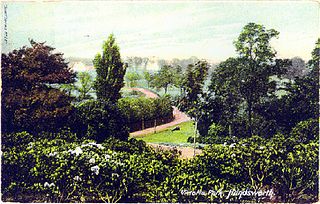
Handsworth Park is a park in the Handsworth area of Birmingham, England. It lies 15 minutes by bus from the centre of Birmingham and comprises 63 acres of landscaped grass slopes, including a large boating lake and a smaller pond fed by the Farcroft and Grove Brooks, flower beds, mature trees and shrubs with a diversity of wildlife, adjoining St. Mary's Church, Handsworth to the north, containing the graves of the fathers of the Industrial Revolution, James Watt, Matthew Boulton and William Murdoch, and the founders of Aston Villa Football Club and the Victoria Jubilee Allotments site to the south opened on 12 June 2010. The completion of a £9.5 million restoration and rejuvenation of Handsworth Park was celebrated with a Grand Re-Opening Celebration led by Councillor Mike Sharpe, the Lord Mayor of Birmingham, speaking from the restored bandstand at 2.00pm on Saturday 8 July 2006, followed by a count down by a large enthusiastic crowd and the release of clouds of confetti; in the words of one observer "Great wedding! Now we must make the marriage a success."

The County Police Act 1839 was an Act of the Parliament of the United Kingdom. It was one of the Police Acts 1839 to 1893. The Act enabled Justices of the Peace in England and Wales to establish police forces in their counties. The Act was not compulsory, and constabularies were only established in 25 out of 55 counties by 1856, when the County and Borough Police Act 1856 made their provision mandatory.

John Henry Chamberlain, William Martin, and Frederick Martin were architects in Victorian Birmingham, England. Their names are attributed singly or pairs to many red brick and terracotta buildings, particularly 41 of the forty-odd Birmingham board schools made necessary by the Elementary Education Act 1870.
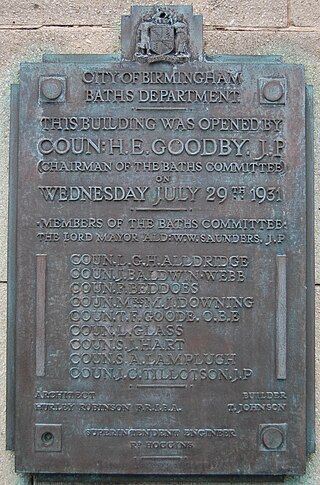
The Birmingham Baths Committee was an organisation responsible for the provision and maintenance of public swimming and bathing facilities. Birmingham City Council funded, constructed and ran bathing facilities throughout the city. The movement to develop baths and wash houses in Britain had its impetus with the rapid urbanisation of the Industrial Revolution, which was felt acutely in Birmingham, one of England's powerhouses.
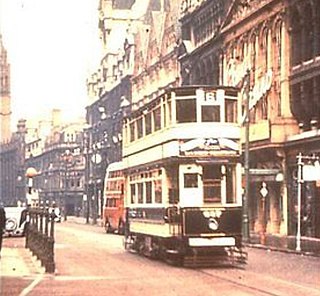
Birmingham Corporation Tramways operated a network of tramways in Birmingham from 1904 until 1953. It was the largest narrow-gauge tramway network in the UK, and was built to a gauge of 3 ft 6 in. It was the fourth largest tramway network in the UK behind London, Glasgow and Manchester.

King's Norton and Northfield Urban District was a local government administrative district in north Worcestershire, England, from 1898 until 1911. Much of its area was afterwards absorbed into the neighbouring Borough of Birmingham, under the Greater Birmingham Scheme, and now constitutes most of the city's southern and southwestern suburban environs.

The Town Police Clauses Act 1847 is an Act of the Parliament of the United Kingdom. The statute remains in force in both the United Kingdom and the Republic of Ireland, and is frequently used by local councils to close roads to allow public events such as processions or street parties to take place. The Act is also used to regulate the local hackney carriage, taxi and private-hire trade in many areas. It deals with a range of street obstructions and nuisances, for example, it makes it illegal to perform certain actions in a public street or other thoroughfare, such as hanging washing, beating carpets, and flying kites, although many of those clauses were repealed in 2015. Historically, it was highly significant legislating against indecent exposure, indecent acts, obscene publications, and prostitution.
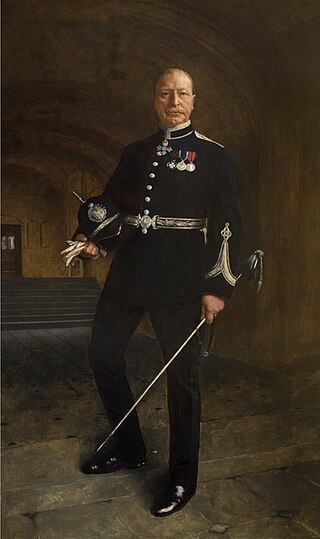
Sir Charles Haughton Rafter was a British police officer who served as Chief Constable of the Birmingham City Police from 1899 until his death in 1935.
Birmingham Market Police is a defunct police force of the United Kingdom which existed between 1883 and 1976, and was formerly under the control of Birmingham Corporation where it was responsible for policing the markets controlled by the corporation. Constables of the market police were attested under section 104 of the Birmingham Corporation (Consolidation) Act 1883 which gave them the same powers and privileges as borough constables appointed under the Municipal Corporations Act 1882, but the part of the 1882 act that related to borough constables had been completely repealed by 1976 and therefore such constables no longer enjoy any powers.
Liverpool Parks Police was a police force maintained by the Corporation of Liverpool to police the parks and open spaces owned by the city. The first record of "park constables" in Liverpool is from 1832, although members of the force were not sworn in as constables in their own right until 1882. The force was disbanded in 1972.
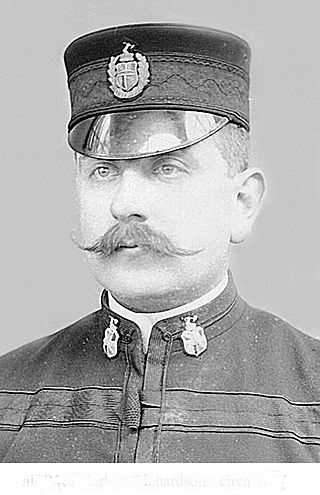
Alfred Herbert Richardson (1874–1951) was an English policeman. He joined the Birmingham City Police in 1890. He achieved very rapid promotion within this force and in 1901 became chief constable of Newcastle-under-Lyme, Staffordshire. In 1903 he successfully applied for the chief constable's office at Halifax, West Riding of Yorkshire, where he remained until his retirement in 1944. During his time there he achieved many early improvements in policing at Halifax, some of which were later used nationwide. The most notable were the installing of coloured lights as traffic signals at road junctions, the formalisation of procedures for police identity parades, making 'keep left' mandatory for traffic and the installation of police telephones in the town, among others. In later years he was recognized as being a policeman who was ahead of his time. He came from a police family: his father, Frank Richardson (1851–1938), was the Chief Constable of Hereford from 1882 until 1920, and his elder brother, Ernest Frank Richardson (1871–1952), served as Chief Constable of Salisbury between 1903 and 1929. Thus three members of the Richardson family served as chief constables between 1902 and 1920. He also had three other brothers who served in other police forces.
Florence Mildred White was an English policewoman. She was likely to have been the first documented woman to join a police force in England and Wales, and to be attested immediately as a Constable. Later she was to become the first attested woman officer holding the rank of Inspector, and the first female police officer to receive a pension on retirement.
Frank Richardson (1851–1938) was an English policeman. He joined the Birmingham City Police in 1873 as a constable third class. Within one year he was promoted to constable second class and one year later to constable first class. In 1878 he was promoted to sergeant within the same force, and in 1882 he applied to be chief constable of Hereford, Herefordshire and was successful. He remained in this post, receiving the King's Police Coronation Medal in 1912 and being decorated at Buckingham Palace in 1917. He was at that time the "Most Senior Chief Constable of England" He had married in 1870 and had nine children of which seven were sons with only one not joining the police service. In total he and his family provided 176 years service to the constabularies of England and South Africa. Between 1903 and 1920 there were three Chief Constable Richardsons in office. He was also the chief fire brigade officer of Hereford, adding many innovations to the fire service.

Birmingham Market Hall was a municipal market hall in the Bull Ring area of Birmingham, England, from 1835 until 1940, when the interior and roof were destroyed by wartime bombing; although the shell of the building remained in use until final demolition in the 1960s.















